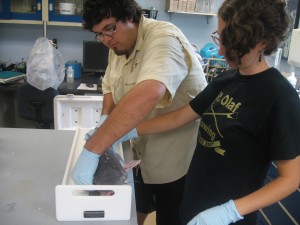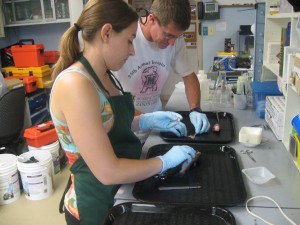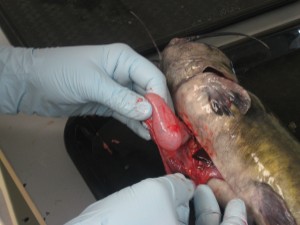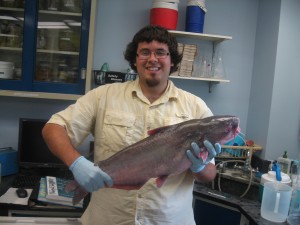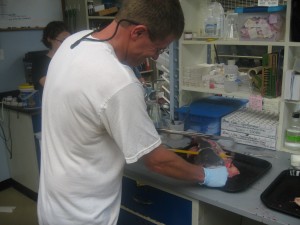By Katie Sinclair
Ever wonder what a catfish eats? The blue catfish, invasive to the Chesapeake, is not a picky eater.
This voracious predator eats pretty much anything that can fit in its mouth. By digging into their stomachs, a process vaguely reminiscent of high school biology classes, researchers can figure out the impact this species has on the ecosystem.
In order to get some fresh catfish stomachs, researchers working in the Fish and Invertebrate Lab at SERC set up a “Gon’ fishing” sign and hit the field.
Using a technique known as “electrofishing,” researchers stun the fish with electric currents in the water and collect them from several sites along the Chesapeake and rivers that feed into the Bay. Once the fish are caught, they place them into a cooler. The frozen fish are then identified by species, weighed and measured. Each fish varies tremendously: From a few ounces to over 10 lbs., a wide range of maturities and sizes are represented.
The ecologists then remove the fish’s stomach, taking great care to keep it intact. (Though frozen, the contents of a fish’s lower intestines tend to have a rather unpleasant smell). As fishermen know, gutting catfish can get messy, especially when the interns get involved.
While most people would consider fish guts to be on the more boring side of the spectrum, you do run into surprises: From eggs to parasites, you never know what you’ll pull out of a catfish’s belly. Once they remove the stomach lining, the stomach contents are rinsed and bagged in labelled plastic bags. While it is nearly impossible to ID species present in the partially digested goo by sight, DNA “barcoding” allows tissue in the stomach to be matched to species present in the bay. This unique “barcode” lets scientists determine what, exactly, each catfish is eating.
One of the highlights of the day occurred when this 10-pound blue catfish was brought in. While the record for blue catfish caught in the watershed is over eight times the size of this guy it’s still pretty impressive.
With blue catfish, there are several more steps to the process. A tissue sample is removed for DNA analysis. The otolith, or the ear bone in a fish, can also give important data on a fish’s life history. While valuable, the tiny bone requires a bit of excavating. The easiest way is to remove the head and pull out the bone from near the eye. Similar to tree rings, looking at patterns of mineralization on the bone can help determine the fish’s age.

